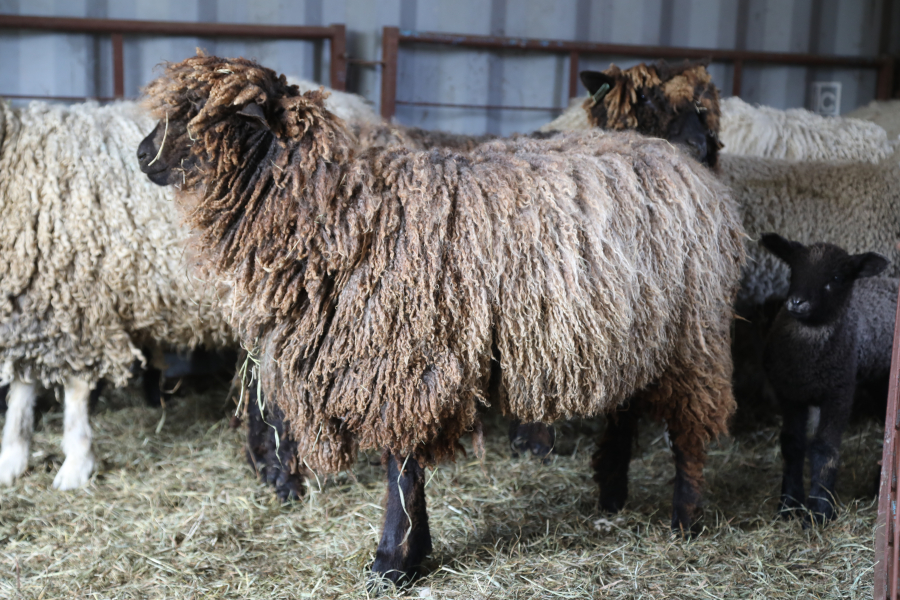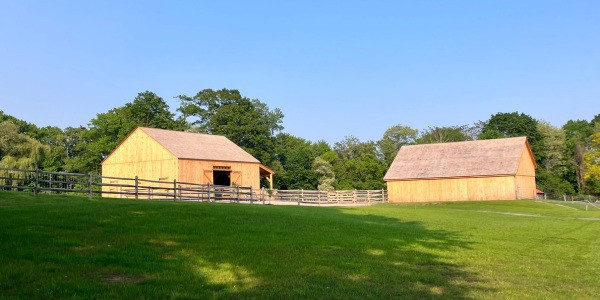
Walk through history at Gore Place and see the animals, crops, and buildings of a nineteenth-century gentleman’s farm.
Animals
Leicester Longwool
The Leicester Longwool was highly prized in the U.S. in the late 1700s and early 1800s, but its popularity declined over the following decades as the wool of other breeds—namely the Merino—jumped in value. By the 1940s the Leicester Longwool could hardly be found in the U.S., but thanks to small populations kept by farmers in Canada and Australia the breed managed to avoid extinction. The breed remains rare today, and our flock at Gore Place plays an important part in its preservation. As the Livestock Conservancy, a preservation organization, writes, “The Leicester Longwool has been of great historic and genetic value, having a part in the founding or improving of many other breeds, including the Border Leicester and the Corriedale. While distinguished by its past, this breed’s future is far from secure, and it is a conservation priority.” To learn more about the Leicester Longwool sheep, click here.
Chickens
Dominique chickens were one of the first chicken breeds to be raised in North America. Brought across the Atlantic by English colonists in the early 1600s, the Dominique—known for its brown eggs and black-and-white plumage—has been raised on American farms ever since. The Gores raised chickens, and while the specific breeds are unknown, it’s likely that Dominiques were among them.
After decades of declining popularity in the United States, the Dominique nearly went extinct in the late 1900s. The Livestock Conservancy listed them as “critical” as late as 2003, but with the help of farms like Gore Place their population has stabilized.
Angora Goats
Angora goats are named for the ancient Ottoman province of Ankara, Turkey, where they have lived and grazed for at least 2000 years. First imported from Turkey and South Africa to America in the mid-19th Century, Angora goat herds quickly became widespread across the United States. Their white, soft, silky, mohair fur has long been utilized in the textile industry, but the expansion of the use of synthetic fibers has led to the goats’ steady decline in recent decades. Known for their relaxed, docile, and friendly nature in addition to their beautiful hair, the Angora goats have been a welcome addition to our farm at Gore Place.
Guinea Fowl
If you visit the farm at Gore Place, you are unlikely to miss the guinea fowl. Guinea fowl are a large breed of gamebird, originally from Africa, with long legs and necks and beautiful black or white plumage. Known as farmyard watchdogs, guinea fowl will sound an alarm whenever anything unusual occurs on a farm. Their loud calls can deter predators and pests; in addition, they eat slugs, ticks, grasshoppers, flies, and crickets, and have even been known to attack snakes, making our guinea fowl valuable, if noisy, companions to our flock of chickens.
Pigs
While our Farm today doesn't have pigs, like most New England farmers in the 1800s, Christopher Gore would have raised pigs on his estate. Like chickens, sheep, and cattle, pigs were some of the first animals brought by Europeans to North America. Pigs are a reliable source of meat, as they reproduce quickly and can weigh upwards of 700 pounds.
Pigs are very social and intelligent. Although they seem messy, pigs are quite resourceful and hygienic: they designate separate areas for waste, and cover themselves in mud to stay cool and prevent sunburns.

Crops: What’s Growing?
The Garden
Much like the Gores’ “kitchen” garden, our garden today grows a variety of vegetables. Though the Gores’ kitchen garden was relatively small compared to the fields growing corn or hay, it was still an important part of the estate and was under the care of a garden manager.
Fruit trees
Apples have a long history in Massachusetts, and by growing them today Gore Place takes part in a tradition dating back to the 1620s. In 1623 Boston became the site of the first documented apple orchard in North America, and since then the apple has become one of the state’s signature fruits.
Gardeners at the Gore estate dedicated much time and effort to growing and breeding fruit. The Gores’ greenhouse, which was heated in the winter, housed citrus trees otherwise impossible to grow in the northeast, and near the greenhouse was a fruit wall for growing grapes. Horticultural experimentation was of great interest to the Gores, and one of their garden managers even bred the prize-winning “Heathcot pear” in 1834.
Like all New Englanders in the early nineteenth century, the Gores drank cider. Long-time farm manager Jacob Farwell wrote of “making cider” several times each fall, suggesting a great deal of the orchard’s harvest was pressed into cider.
Our apple, pear, and peach trees can be found in front of the mansion beside the four-acre pasture and along our perimeter walk.

Farm Buildings
The Carriage House
The Gores’ Carriage House was built in 1793. The building was an important part of the estate, as it housed carriages, horses, and stored a range of equipment including harnesses, saddles, bridles and other tack. Hay and grain were also stored in the Carriage House, and the cellar was utilized to make compost for fertilizing fields.
The Farm House
The Farm House at Gore Place was first built in 1835. It was originally located across the “Old Back Road”—now Waltham Street––but has since been moved and rebuilt at its current location.
The Barns
Based on historical designs, the threshing and pole barns at Gore Place bring a sight from rural nineteenth-century Massachusetts to the present day. Both barns play a variety of important roles on the farm today, from storing tools and equipment to providing shelter for our animals.

Sights and Sounds
The fifty acres of fields and woods at Gore Place provide a sanctuary for wildlife.
Farmland has been in steep decline in Massachusetts for over a century, and while this has led to beneficial reforestation, farm abandonment has come at a great cost to rural habitats and local agriculture. By maintaining a historic landscape that is both ecologically diverse and agriculturally productive, Gore Place protects wildlife and helps build a more sustainable future for the state. Walk through our fields and woods to experience a glimpse of rural life in the nineteenth century for yourself!
Woods and Wildlife
Massachusetts in the Gores’ time was far different than today. Deforestation was intensifying, and a rolling landscape now covered by trees was instead dominated by meadows and fields. So what kind of plants and animals lived in this environment? In addition to many more farm animals, Massachusetts in the early nineteenth-century was home to a range of creatures and plants that thrived in a pastoral landscape. Small rodents and ground-nesting birds, for example, made homes in meadows full of tall grass and wildflowers. The quail, bobolink, and woodcock were all common, as were field mice and groundhogs. But as farms were abandoned and fields were overtaken by trees and shrubs, the composition of wildlife changed drastically.
Today, nearly 70 percent of Massachusetts is covered by forest, and countless species that once disappeared from the region have since returned. Birds like thrushes, woodpeckers, and warblers are far more common, and even large mammals, like moose, can be found in the state. But in areas like Greater Boston, urban and suburban sprawl and commercial development have contributed to another wave of deforestation, and threatens the progress made in years past. Whether woods or farmland, crucial habitats are once again threatened, and continuous work is needed to protect them. By protecting fifty acres of fields, woods, and farmland in the heart of Waltham and Watertown, Gore Place provides a community resource and a sanctuary for wildlife.
Stone walls
For hundreds of years stone walls have been a defining feature of the Massachusetts landscape. Built by farmers removing stones from their land, these walls are a reminder of the state’s agrarian past, and can be seen and felt here at Gore Place. But like the long history of farming they recall, Massachusetts’s stone walls have been obscured by a returning forest and changing environment. Often abandoned and dilapidated, most walls today are little more than winding lines of tumbling stones, collapsing due to weather, development, and even theft. Even in their crumbling state, however, these walls tell an important story.
To learn more about the history of these walls, check out the University of Connecticut’s “Stone Wall Initiative” here.
Interested in Farm programs and events? See "What's On" at Gore Place, or subscribe to our email newsletter below!




